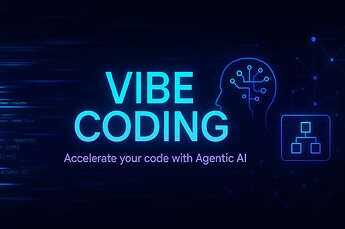How To Start Vibe Coding Without Prior Experience Using AI Tools ![]()
![]()
Vibe Coding is a revolutionary development approach that fuses AI-powered programming with no-code and low-code platforms, allowing complete beginners to create professional-grade digital products without mastering traditional programming languages. This technique shifts the focus from writing every line of code to orchestrating AI-driven workflows—so you can think like a creator, not just a coder.
![]()
Vibe Coding combines AI-powered programming, no-code builders, and automation tools into a streamlined workflow that allows anyone—from absolute beginners to advanced creators—to build real-world projects fast. By using AI to handle the heavy lifting of coding, debugging, and integration, you can focus on creativity, functionality, and deployment.
![]()
![]()
What is Vibe Coding?
Vibe Coding is the practice of building applications, websites, tools, and creative projects using AI as your main development partner. Instead of spending months learning syntax, you describe what you want in plain language, and AI:
-
Writes and optimizes code
-
Suggests project structures
-
Fixes bugs automatically
-
Generates visuals, videos, and other media assets
-
Integrates APIs and external services without manual setup
Best AI Tools for Vibe Coding
AI Coding Assistants
-
GitHub Copilot – AI pair programmer that generates code in real time inside your editor.
-
Replit Ghostwriter – AI-enhanced cloud IDE with code generation, error fixing, and instant deployment.
-
ChatGPT Code Interpreter – Turns natural language into working code with debugging and data analysis.
No-Code/Low-Code Builders
-
Glide – Build mobile apps from spreadsheets with AI-assisted logic.
-
Bubble – Drag-and-drop web app builder with AI plugins and API integrations.
-
Adalo – Create mobile apps visually, enhanced with AI automations.
Creative AI Tools
-
Runway ML – AI for image, video, and animation generation.
-
Pika Labs – Create animated visuals for web or app interfaces.
-
Leonardo AI – Game asset and illustration generator with AI customization.
Step-by-Step Beginner Guide
-
Pick Your Platform – Start with Replit for AI code guidance or Bubble for no-code app building.
-
Start Simple – Try projects like a weather dashboard, personal portfolio, or AI chatbot.
-
Use AI for Problem Solving – Ask ChatGPT for explanations, error fixes, and optimization tips.
-
Enhance with AI Media – Use Runway ML or Leonardo AI for custom images and animations.
-
Automate Deployments – Launch projects instantly with Vercel or Netlify.
Pro Tips & Advanced Tricks
-
Master Prompt Engineering – Use detailed prompts for AI to produce higher-quality code. Example:
"Create a responsive e-commerce product grid with sorting and filtering in React, styled with Tailwind CSS." -
Mix AI-Generated Code with No-Code UI – Let AI handle backend logic while no-code tools design the front end.
-
Leverage API Connectors – Platforms like Make and Zapier let you connect AI-powered workflows between apps without coding.
-
AI Testing Automation – Use Testim or Mabl to run automated tests generated by AI.
-
Integrate Multiple AI Models – Combine GPT for text, Stable Diffusion for images, and Whisper for speech recognition in one app.
Hidden Automation Shortcuts
-
One-Click AI Database Setup – Tools like Supabase let you spin up a backend database instantly; AI can pre-generate your schema.
-
Automated Content Populators – Use Copy.ai or Jasper to fill your app with placeholder or real content in seconds.
-
AI-Driven UX Tweaks – Hotjar integrated with AI can suggest layout improvements based on user behavior.
-
Autonomous AI Agents – Tools like AutoGPT or CrewAI can run development tasks continuously without constant supervision.
![]()
Vibe Coding Power Stack Chart
| Goal | AI Coding Assistant | No-Code / Low-Code Builder | Automation / APIs | Creative AI |
|---|---|---|---|---|
| Startup MVP / SaaS | GitHub Copilot | Bubble | Make or Zapier | Leonardo AI for branding assets |
| Mobile App Development | Replit Ghostwriter | Adalo | Supabase for backend | Runway ML for visuals |
| Automation & Workflows | ChatGPT Code Interpreter | Glide | Pipedream for API tasks | Midjourney for UI concepts |
| Creative Projects & Art | Claude AI | Webflow | IFTTT | Pika Labs & Runway ML |
| Game Development | Cursor | Unity Visual Scripting | Firebase | Leonardo AI for assets & Stable Diffusion |
| Data Tools & Dashboards | Codeium | Retool | Postman for API testing | Canva for UI elements |
How to Use the Power Stack
-
Pick your goal → Choose the row that matches your project idea.
-
Combine tools across columns → Example: For a mobile app, you might use Replit Ghostwriter + Adalo + Supabase + Runway ML.
-
Iterate quickly → Start small, test often, and let AI generate improvements automatically.
-
Deploy instantly → Platforms like Vercel or Netlify can host your project in one click.
Extra Efficiency Hacks
-
Use AI to create database schemas → Prompt ChatGPT to design database tables for your app before using Supabase.
-
Automate user onboarding → Connect Make to your app’s signup process for instant email sequences.
-
AI-driven bug hunting → Run your code through Codeium or Cursor to find issues before deployment.
-
Hybrid AI & No-Code UI → Build core features with AI coding tools, then wrap them in a polished interface using no-code builders.
![]()
Why Vibe Coding Works for Everyone:
By combining AI code generation, no-code design tools, and automation platforms, you can go from concept to live product in hours—not months. Whether you’re launching a startup, building a side hustle app, or experimenting with creative ideas, Vibe Coding makes professional development faster, cheaper, and accessible to all.
![]()

 !
!